
CSS3 Menu Button by Css3Menu.com



|
|
|||||
|
|
 |
|
|||
|
|
|||||
|
CSS3 Menu Button by Css3Menu.com |
|||||
 |
 |
|
 |
||
|
|
September, 2009: Tons of trilling tamarins (and some others...)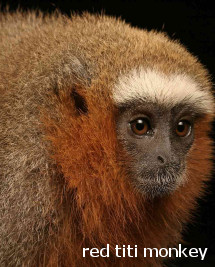 Far from their native homes in the tropical forests of South America, diminutive tamarin monkeys call the urban jungle of Southern California home. The Santa Ana Zoo boasts one of the largest collections of these monkeys on the West Coast and recently grew by two more with the addition of a pair of endangered golden-headed lion tamarins. Black in coloration with a stunning mane of golden fur, golden-headed lion tamarins hail from the Atlantic coastal rainforest of Brazil. There are less than one-hundred of these tamarins in the United States and we are pleased to participate in a captive breeding program organized by the Association of Zoos and Aquariums and led by the National Zoo in Washington D.C.
Some other new residents are a pair of red titi monkeys. Titi monkeys (pronounced tee-tee) actually refers to some thirty species from South America. Titi, meaning "little cat" derives from the language of the Aymara people that live in the Andes Mountains in South America. Titi monkeys bond very closely with one another and often times will sit on a branch with their tails intertwined together. Red titi monkeys give birth to a single offspring approximately once a year and live in small family groups with the parents and one or two weaned offspring. Look for these animals and more at the Santa Ana Zoo at Prentice Park.
Far from their native homes in the tropical forests of South America, diminutive tamarin monkeys call the urban jungle of Southern California home. The Santa Ana Zoo boasts one of the largest collections of these monkeys on the West Coast and recently grew by two more with the addition of a pair of endangered golden-headed lion tamarins. Black in coloration with a stunning mane of golden fur, golden-headed lion tamarins hail from the Atlantic coastal rainforest of Brazil. There are less than one-hundred of these tamarins in the United States and we are pleased to participate in a captive breeding program organized by the Association of Zoos and Aquariums and led by the National Zoo in Washington D.C.
Some other new residents are a pair of red titi monkeys. Titi monkeys (pronounced tee-tee) actually refers to some thirty species from South America. Titi, meaning "little cat" derives from the language of the Aymara people that live in the Andes Mountains in South America. Titi monkeys bond very closely with one another and often times will sit on a branch with their tails intertwined together. Red titi monkeys give birth to a single offspring approximately once a year and live in small family groups with the parents and one or two weaned offspring. Look for these animals and more at the Santa Ana Zoo at Prentice Park.
June, 2009: Stork Visits Santa Ana Zoo! 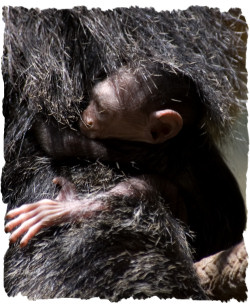 The Santa Ana Zoo in Prentice Park is pleased to announce the birth of a baby saki monkey on May 18. The new baby, whose sex is yet unknown, has been determined as healthy and full of energy!
This birth represents the fourth successful pairing between proud parents Dakota and Aaliyah. The happy saki family can be viewed in the Tropical Rainforest multi-species exhibit behind the Conservation Education Theater.
The Santa Ana Zoo in Prentice Park is pleased to announce the birth of a baby saki monkey on May 18. The new baby, whose sex is yet unknown, has been determined as healthy and full of energy!
This birth represents the fourth successful pairing between proud parents Dakota and Aaliyah. The happy saki family can be viewed in the Tropical Rainforest multi-species exhibit behind the Conservation Education Theater.
March, 2009: Stork Visits Santa Ana Zoo!  The Santa Ana Zoo at Prentice Park is pleased to announce the birth of golden lion tamarin monkeys on March 21st, 2009. The two new babies are healthy and full of energy! The proud first time parents and their babies have been given special privacy and are not on public display.
These are the second set of golden lion tamarin babies born at the Zoo this year. Be sure to check out our first set of twins born on January 20th, 2009, on display in the north end of the Zoo. These youngsters are often seen away from their parents exploring their home.
Golden lion tamarins are a highly endangered species found in the Atlantic coastal rainforests of Brazil. They use their long slender fingers to probe small crevices in plants like bromeliads for tasty insects. Golden lion tamarins also snack on various fruits as they forage through the rainforest canopy.
The Santa Ana Zoo at Prentice Park is pleased to announce the birth of golden lion tamarin monkeys on March 21st, 2009. The two new babies are healthy and full of energy! The proud first time parents and their babies have been given special privacy and are not on public display.
These are the second set of golden lion tamarin babies born at the Zoo this year. Be sure to check out our first set of twins born on January 20th, 2009, on display in the north end of the Zoo. These youngsters are often seen away from their parents exploring their home.
Golden lion tamarins are a highly endangered species found in the Atlantic coastal rainforests of Brazil. They use their long slender fingers to probe small crevices in plants like bromeliads for tasty insects. Golden lion tamarins also snack on various fruits as they forage through the rainforest canopy.
February, 2009: Tons of Trilling Tamarins at the Santa Ana Zoo at Prentice Park, "Home of the 50 Monkeys" 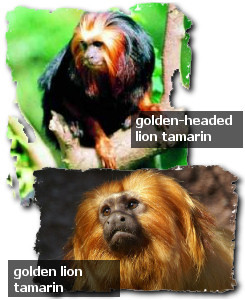 The Santa Ana Zoo, already boasting one of the largest collections of tamarin monkeys on the West coast, has grown by two more with the addition of a pair of endangered golden-headed lion tamarins. Black in coloration with a stunning mane of golden fur, golden-headed lion tamarins hail from the Atlantic coastal rainforest of Brazil.
There are less than one-hundred of these tamarins in the United States, and the Zoo is pleased to participate in a captive breeding program organized by the Association of Zoos and Aquariums and led by the National Zoo in Washington D.C.
The new monkeys can now be seen at the North End of the Zoo in a new area designed for them.
In addition to these tamarins, the Zoo is delighted by the recent birth of a pair of golden lion tamarins on January 20th. Another endangered primate native to the forests of Brazil, this birth is an important contribution to the captive breeding program.
The Santa Ana Zoo, already boasting one of the largest collections of tamarin monkeys on the West coast, has grown by two more with the addition of a pair of endangered golden-headed lion tamarins. Black in coloration with a stunning mane of golden fur, golden-headed lion tamarins hail from the Atlantic coastal rainforest of Brazil.
There are less than one-hundred of these tamarins in the United States, and the Zoo is pleased to participate in a captive breeding program organized by the Association of Zoos and Aquariums and led by the National Zoo in Washington D.C.
The new monkeys can now be seen at the North End of the Zoo in a new area designed for them.
In addition to these tamarins, the Zoo is delighted by the recent birth of a pair of golden lion tamarins on January 20th. Another endangered primate native to the forests of Brazil, this birth is an important contribution to the captive breeding program.
October 8, 2008: Stork Visits Santa Ana Zoo-Twice! 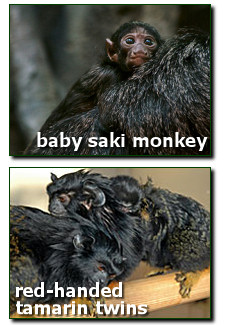 The Santa Ana Zoo in Prentice Park is pleased to announce the birth of a baby saki monkey on August 21. The new baby, whose sex is yet unknown, has been determined as healthy and full of energy! This birth represents the third successful pairing between proud parents Dakota and Aaliyah. The happy saki family can be found Tropical Rainforest multi-species exhibit behind the Conservation Education Theater.
Also at the Santa Ana Zoo, twin red-handed tamarins were born on August 17. These two new babies are also doing very well. The red-handed tamarins are new to the Santa Ana Zoo, and this represents the first offspring from them here at the Zoo. The red-handed tamarins can be found along the back of the Zoo in the enclosure across from the Treetops Exhibit.
The Santa Ana Zoo in Prentice Park is pleased to announce the birth of a baby saki monkey on August 21. The new baby, whose sex is yet unknown, has been determined as healthy and full of energy! This birth represents the third successful pairing between proud parents Dakota and Aaliyah. The happy saki family can be found Tropical Rainforest multi-species exhibit behind the Conservation Education Theater.
Also at the Santa Ana Zoo, twin red-handed tamarins were born on August 17. These two new babies are also doing very well. The red-handed tamarins are new to the Santa Ana Zoo, and this represents the first offspring from them here at the Zoo. The red-handed tamarins can be found along the back of the Zoo in the enclosure across from the Treetops Exhibit.
May 12, 2007: Stork Visits Santa Ana Zoo 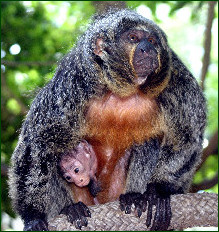 The Santa Ana Zoo in Prentice Park is pleased to announce the birth of a white-face saki monkey on Thursday, May 3. The new baby has been determined as healthy and full of energy by Zoo veterinarian Dr. Lorrie Boldrick. White faced sakis are not common in the tropical rain forests of South America. Although there appears to be no immediate threat to their populations, AZA accredited zoos in the United States are cooperating in breeding so there is no need to import them from the wild.
Adult males are black with a white face. Females are brownish-grey with a narrow white stripe on the face between the inner eye and mouth. Both have long shaggy coats and non-prehensile, bushy tails. Body weight is 3 to 4 pounds. Their body length is 12-16 inches with their tail being about the same length as their body.
In the wild, their diet consists of fruit, berries, seeds, nuts, flowers and leaves. At the Zoo, they eat fruits, vegetables, and a special zoo diet of Monkey Chow. They have large canine teeth for opening nuts and tough fruit. They cup their hands to drink water.
The Santa Ana Zoo in Prentice Park is pleased to announce the birth of a white-face saki monkey on Thursday, May 3. The new baby has been determined as healthy and full of energy by Zoo veterinarian Dr. Lorrie Boldrick. White faced sakis are not common in the tropical rain forests of South America. Although there appears to be no immediate threat to their populations, AZA accredited zoos in the United States are cooperating in breeding so there is no need to import them from the wild.
Adult males are black with a white face. Females are brownish-grey with a narrow white stripe on the face between the inner eye and mouth. Both have long shaggy coats and non-prehensile, bushy tails. Body weight is 3 to 4 pounds. Their body length is 12-16 inches with their tail being about the same length as their body.
In the wild, their diet consists of fruit, berries, seeds, nuts, flowers and leaves. At the Zoo, they eat fruits, vegetables, and a special zoo diet of Monkey Chow. They have large canine teeth for opening nuts and tough fruit. They cup their hands to drink water.
May 18, 2006: Twins Born at Santa Ana Zoo 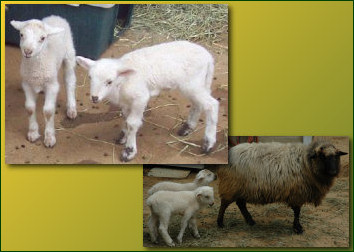 The Santa Ana Zoo at Prentice Park is pleased to announce that on Thursday, April 20, at 10:00 PM, twin lambs, "Hogan" and "Diyogi" were born to Navajo-Churro sheep parents, Dibe and Shadi. Weighing 8 pounds at birth, both boys are doing fine and growing rapidly.
The Navajo-Churro was the first domesticated sheep introduced into North America by The Spaniards in the 17th century. After almost becoming extinct in the mid-1900ís, the breed is now recovering and becoming more poplar, though still considered a "rare" breed.
Churros are small sheep with ewes ranging from 85 to 120 pounds and rams 120-175 pounds. They carry a unique gene which allows them to produce multiple horns, and both rams and ewes can be horned. Their wool comes in many colors including apricot, grey, black, brown, beige, and white. It is lustrous with a silky hand and low lanolin content. Yarn spun from this type of wool is extremely strong and durable making it excellent for the Navajo rugs.
The Santa Ana Zoo at Prentice Park is pleased to announce that on Thursday, April 20, at 10:00 PM, twin lambs, "Hogan" and "Diyogi" were born to Navajo-Churro sheep parents, Dibe and Shadi. Weighing 8 pounds at birth, both boys are doing fine and growing rapidly.
The Navajo-Churro was the first domesticated sheep introduced into North America by The Spaniards in the 17th century. After almost becoming extinct in the mid-1900ís, the breed is now recovering and becoming more poplar, though still considered a "rare" breed.
Churros are small sheep with ewes ranging from 85 to 120 pounds and rams 120-175 pounds. They carry a unique gene which allows them to produce multiple horns, and both rams and ewes can be horned. Their wool comes in many colors including apricot, grey, black, brown, beige, and white. It is lustrous with a silky hand and low lanolin content. Yarn spun from this type of wool is extremely strong and durable making it excellent for the Navajo rugs.
April 12, 2005: Gloucestershire Old Spots Pigs 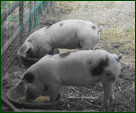 These little piggies will never go to market! The Santa Ana Zoo announces the arrival of two rare breed pigs called Gloucestreshire Old Spots (GOS) pigs. Our girls were born on a farm in Oregon on April 12, 2005, and air-shipped to the Zoo. The breed originated in England, and they were sometimes called "orchard pigs," as they were turned loose in fruit orchards to clean up the fallet fruit from the ground.
The Crean Family Farm is focusing on these domestic animals for education and promotion of such rare breeds. The GOS are part of our effort to preserve the rare breeds and to teach our patrons that there is such a thing as "endangered" farm animals. Please come by and visit our pigs on your trip down to the Crean Family Farm.
These little piggies will never go to market! The Santa Ana Zoo announces the arrival of two rare breed pigs called Gloucestreshire Old Spots (GOS) pigs. Our girls were born on a farm in Oregon on April 12, 2005, and air-shipped to the Zoo. The breed originated in England, and they were sometimes called "orchard pigs," as they were turned loose in fruit orchards to clean up the fallet fruit from the ground.
The Crean Family Farm is focusing on these domestic animals for education and promotion of such rare breeds. The GOS are part of our effort to preserve the rare breeds and to teach our patrons that there is such a thing as "endangered" farm animals. Please come by and visit our pigs on your trip down to the Crean Family Farm.
December 2, 2004: Colobus Monkey 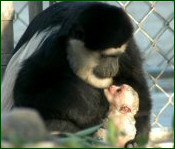 Asha, an 11-year old colobus monkey, gave birth to our newest arrival on December 2, 2004. According to keeper Ray Cosper, the newborn is the first of its species to be born at the Zoo in at least 22 years.
Asha, an 11-year old colobus monkey, gave birth to our newest arrival on December 2, 2004. According to keeper Ray Cosper, the newborn is the first of its species to be born at the Zoo in at least 22 years. |
|
|
 |
Home |
Visitor Information |
Conservation |
News & Events |
Support Us |
Contact
ADD SAZOO TO MY FAVORITES | © 2007-2023 Santa Ana Zoo at Prentice Park. All Rights Reserved. |
 |
|
|
|
||||